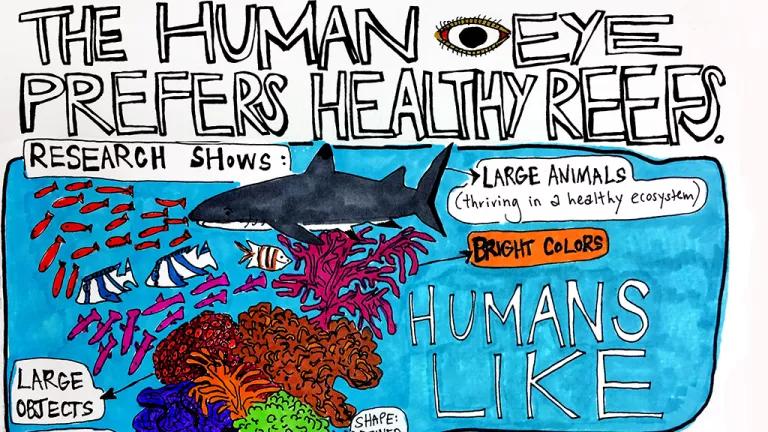
Imagine you’re snorkeling over a pristine coral reef. You see mandarin-orange fan corals gently wafting in the current, pink sea anemones waiting for prey, fish poking around huge, neon-bright brain corals—all against a crystal blue backdrop. Now, what do you feel? Disgust? Abhorrence? A need to get out of the water as soon as possible?
Probably not. Humans largely consider coral reefs beautiful, but have you ever wondered why they appeal to us so much? Math, biology, and art history scholars from San Diego State University, the Getty Research Institute, and the Scripps Institution of Oceanography have wondered, and they’re developing a way to calculate that aesthetic appeal in an attempt to save the world’s coral ecosystems. They’ve teamed up to design a computer program that uses humans’ emotional reactions to reefs as an inexpensive means of assessing coral health.
Reef systems across the globe are suffering. Rising sea temperatures, bleaching events, overfishing, and pollution have contributed to the loss of an estimated 27 percent of the world’s reef ecosystems and put an additional 32 percent at risk. That’s a lot of reef for marine scientists to monitor on their own. But it turns out that you don’t need to be a coral expert to know a sick reef when you see one. What’s healthy is what’s beautiful, and these days, what’s beautiful can be measured mathematically.
The science of beauty is a riddle great thinkers have tried to unlock since Plato. Recent research shows that humans like bright colors; large, distinguishable objects; and bold textures that delineate the edges of things—kind of like coral. Other studies have analyzed our emotional responses to certain pieces of art and established some equations that quantify our perception of beauty.
The coral reef researchers used those equations to create a computational tool that analyzed 2,000 photos of reefs from around the world. For each reef, the program generated an aesthetic score. The scientists then compared those beauty scores with previous health assessments of the reefs pictured. They found a close correlation between the two: The reefs that humans and the computer found ugly were the same ones that had been deemed sick by science.
So, now that computers can appreciate the beauty of, say, elkhorn coral, the researchers hope to enlist the masses of snorkelers, divers, and scientists who photograph reefs across the seven seas and get them to upload their images into the database for lightning-fast reef diagnoses. If it works, this could be a quicker and cheaper alternative to sending specialized reef scientists to remote locales to measure the various biogeochemical cues of coral ecosystems. At the very least, the reef doctors will be able to prioritize their house calls.
This article was originally published on onEarth, which is no longer in publication. onEarth was founded in 1979 as the Amicus Journal, an independent magazine of thought and opinion on the environment. All opinions expressed are those of the authors and do not necessarily reflect the policies or positions of NRDC. This article is available for online republication by news media outlets or nonprofits under these conditions: The writer(s) must be credited with a byline; you must note prominently that the article was originally published by NRDC.org and link to the original; the article cannot be edited (beyond simple things such grammar); you can’t resell the article in any form or grant republishing rights to other outlets; you can’t republish our material wholesale or automatically—you need to select articles individually; you can’t republish the photos or graphics on our site without specific permission; you should drop us a note to let us know when you’ve used one of our articles.

How to Become a Community Scientist
Biodiversity 101
How to Start Saving the Planet in 100 Days: the Joe Biden Edition